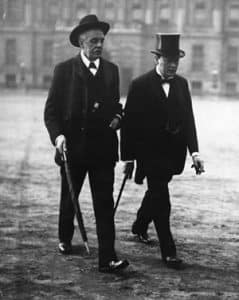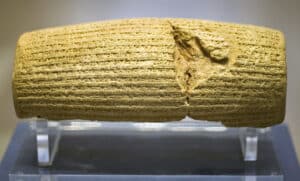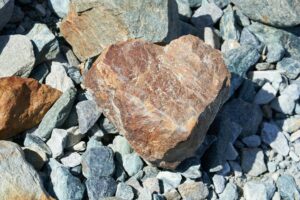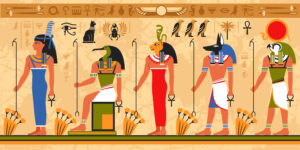
He died almost a hundred years ago, but Lord Balfour is still causing trouble. Yet again, an artistic representation of the British politician was attacked in by pro-Palestine protesters in the UK.
But Balfour was right to make provision for the Jewish people to have a refuge in their ancestral homeland as recent events in Europe are demonstrating all too well.
Jewish people need a safe place to run to, something Lord Balfour understood when he wrote the words of Balfour declaration. He wrote it in 1917, long before the Holocaust, when millions of Jewish people perished precisely because they couldn’t escape. Boats of Jewish people went from port to port and were refused entry in every country, and far too many were eventually forced to return, only to be slaughtered by the Nazis.
Now in our day Jewish people are still being viciously attacked just for being Jewish. We’ve seen sickening “Jew hunts” in Amsterdam, Paris, and Sweden. The need for the state of Israel as a refuge for Jewish people to flee to has become all the more apparent.
Israel haters have said that the very existence of Israel as a homeland for Jewish people is racist, but the truth is that it’s necessary because of the violent antisemitism that never seems to go away.
What is the Balfour Declaration?
Here are the words he wrote:
“I have much pleasure in conveying to you, on behalf of His Majesty’s Government, the following declaration of sympathy with Jewish Zionist aspirations which has been submitted to, and approved by, the Cabinet.
“His Majesty’s Government view with favour the establishment in Palestine of a national home for the Jewish people, and will use their best endeavours to facilitate the achievement of this object, it being clearly understood that nothing shall be done which may prejudice the civil and religious rights of existing non-Jewish communities in Palestine, or the rights and political status enjoyed by Jews in any other country.”
I should be grateful if you would bring this declaration to the knowledge of the Zionist Federation.
Yours sincerely,
Arthur James Balfour”
As you can see, the rights of non-Jewish communities are to be protected, but the zionist aspiration to have a “national home for the Jewish people” is recognized and its establishment supported. It was the first of several important steps towards legal statehood.
Balfour attacks
On the anniversary of the Balfour Declaration on November 2, 2024, two masked and hooded vandals smashed into a glass cabinet containing the busts of Lord Balfour and Israel’s first president, Chaim Weizmann, bundling them both into their bags before taking off.
On the same date in 2023 someone apparently thought it was a good idea to destroy a priceless portrait of the British politician that was hanging in Cambridge University. After destroying the painting of Balfour with spray paint, she then hacked the canvas to pieces with a craft knife.
Palestine Action’s post accused Balfour of beginning “the ethnic cleansing of Palestine by promising the land away — which the British never had the right to do.”
But is that true?
106 years after he wrote a letter that the pro-Hamas mob don’t like, one of their mobsters vandalized a painting of Lord Balfour at the University of Cambridge.
Because THIS will surely #FreePalestine pic.twitter.com/E1UFpaVcuv
— Aviva Klompas (@AvivaKlompas) March 8, 2024
Balfour was a British statesman with the longest ministerial career in British politics after Winston Churchill. He was a Conservative Member of Parliament for fifty years and became prime minister in 1902. However, that was not the peak of his career.
Lord Balfour served as foreign secretary from 1916 to 1919, and it was at this time that he wrote the most important document of his life, giving official approval of the right for Jewish people to make a national home in the land of their forefathers.
A step towards statehood
The Balfour Declaration was the first of several essential stepping stones towards the legal establishment of the State of Israel in 1948.
Contrary to the claim that “the British had no right” to establish a homeland for the Jewish people in Palestine, the British had every right to decolonize the land after ending the 400 year Turkish occupation. After defeating the sprawling Ottoman Empire, they sought to give autonomy back to the indigenous peoples of the Middle East. Recognizing the Jewish ancestral history in the land, Balfour’s declaration was actually an act of decolonization.
a) The Balfour Declaration, November 2, 1917: the UK with support of four other nations declared a homeland for the Jews in Palestine after defeating the Turks who controlled the Middle East previously.
b) The San Remo Article 22, April 1920: Ratified the Balfour Declaration as internationally binding law
c) The League of Nations endorsed the Balfour Declaration on July 24, 1922: A legal document titled “Mandate for Palestine” was unanimously approved by all 51 states of the League, laying down the Jewish legal rights in Palestine: “Recognition has been given to the historical connection of the Jewish people with Palestine and to the grounds for reconstituting their national home in that country.”
d) UN Resolution 181: UN member states voted to partition Palestine in 1947, although with a smaller share for the Jews. The original Mandate for Palestine had given the area east of the Jordan river to the Arabs and west to the Jews, but the UN resolution allotted 77% of that area as a Jewish homeland.
e) The 1948 invasion by the surrounding Arab nations and their surprising defeat led to Israel declaring independence in May of that year.
Israeli historian Benny Morris said that Balfour was “motivated by a desire to do something for the Jews, because they had suffered greatly at the hands of the Christian world during the previous 1,900 years and because of the values and norms, including monotheism and the notions of social justice, that they had bestowed on humankind through the Old Testament.”1
Balfour got to know Chaim Weizmann, a prominent Russian Zionist who would later serve as Israel’s first president, after they met in 1906. They both saw the terrible mistreatment of Jewish people in the Russian pogroms and recognized that a Jewish homeland was necessary as a refuge from persecution.
YNet News describes the Balfour Declaration as “a ray of light in the dark history of Jews in the first half of the 20th century, following persecutions and pogroms and before the Holocaust which nearly eliminated the Jewish people.”2
Israel is necessary in a world that won’t stop hating Jewish people
History is replete with shocking stories of violence and genocide against the Jewish people, and it doesn’t seem to stop. Literally days after the statues were stolen in protest against the Balfour Declaration, we had a clear illustration of exactly why the State of Israel is necessary. Balfour was absolutely right.
On November 7, 2024, the world witnessed shocking scenes of antisemitic violence erupting on the streets of Amsterdam. Israeli football team, Maccabee Tel Aviv, was playing in the Netherlands and while there was ugly behavior on both sides, it soon became clear that there had been a coordinated plan to hunt Jewish Israelis down and brutally attack them. Worse, the police seemed to turn a blind eye.
 In the end, given the seriousness of the threat and the lack of protection from Dutch police, Israel launched a rescue operation to recover hundreds of Israelis from serious danger. In another match that took place in Paris, they had to employ 4000 Gendarmes to provide extra security for the visiting football fans from Israel to prevent another occurrence of the antisemitic attacks, and yet another night of violence happened in Sweden, ironically on the eve of Kristallnacht.
In the end, given the seriousness of the threat and the lack of protection from Dutch police, Israel launched a rescue operation to recover hundreds of Israelis from serious danger. In another match that took place in Paris, they had to employ 4000 Gendarmes to provide extra security for the visiting football fans from Israel to prevent another occurrence of the antisemitic attacks, and yet another night of violence happened in Sweden, ironically on the eve of Kristallnacht.
On “The Quad” talk show on JNS TV, former deputy mayor of Jerusalem Fleur Hassan-Nahoum sat with her guests to dissect the incident in Amsterdam, calling it a terrifying “Jew hunt”.3
They outlined the difference between regular antisemitic violence and a pogrom, saying the definition of a pogrom is that the authorities turn their back or are even complicit. This is why Israel is necessary.
“Can we trust any in Europe to protect Jews now? I guess we’ll see, and that concerns me,” said one.
“No country in Europe has been safe from individual violence … and ultimately it’s hard to stop a crime like that,” they said, “but the police were warned and they took minimal action, almost nothing.”
Posts on social media kicked back at the anti-Israel hostility which regularly involves shouts of “Go back to Europe!”
“We went back to Europe,” they said, “and Israel had to send two rescue planes”.
Is Zionism racist?
Only two United Nations resolutions have ever been revoked, and one of them was Resolution 3379 was passed in 1975, in which the General Assembly linked Zionism and the State of Israel with racism and racial discrimination. Zionism was declared de facto racist, however the truth, of course, is exactly the opposite. The “Zionist enterprise” is not racist, but rather a result of racism.
We have just seen strong and visceral reminders of what happens when Jewish people do not have a safe place to go out in the nations, and why a Jewish state is needed. We have also seen the huge blessing it is to have our Israeli Air Force, able to rescue citizens in peril.
Balfour was also right in hardwiring anti-racism into his declaration, with the clause, “nothing shall be done which may prejudice the civil and religious rights of existing non-Jewish communities in Palestine.” Today 20% of Israelis are Arab speaking, whether they are Muslim, Christian, Druze or Bedouin, and their equal rights are protected by law. That’s not to say that there is no discrimination or racism in Israel—there is, but I’m guessing there is in your country too. However, Israeli Muslims are among the freest in the world, and many Israeli Arabs are happy to live in the Jewish state where they can rise to the top with equal access to all that Israeli society has to offer. Whether it’s access to education, career possibilities, amenities or political representation, the rights of Israeli Arabs are enshrined in law, just as Balfour declared they should be.
A fitting tribute to this fact is the story of Melhem Asad, an Israeli Druze man and lifelong Maccabee Tel Aviv fan. He was in Amsterdam when the horrific events began to unfold, and he used his Arab identity to save Jewish lives by speaking Arabic loudly in groups of Israeli Jews, causing attackers to leave them alone.
Another Arab Israeli named Yosef Haddad praised Asad’s actions, saying how they exemplified brotherhood between Jews and Arabs, showing that peace is possible. He posted on X, “Melhem, you’re a true hero and an example of the true partnership between Jews and Arabs. Thank you for saving Israeli lives yesterday.”
For his part, Asad gave credit to God, saying, “I feel that God sent me at the right time and to the place to save whoever I could.”4
Balfour was right
Back when it was made in 1917, Balfour’s Declaration was likened to that of King Cyrus, the ancient king of Persia who made an official decree that the Israelites could return and that he would help with the restoration of Jerusalem in 539 BC:
In the first year of Cyrus king of Babylon, Cyrus the king made a decree that this house of God should be rebuilt. And the gold and silver vessels of the house of God, which Nebuchadnezzar had taken out of the temple that was in Jerusalem and brought into the temple of Babylon, these Cyrus the king took out of the temple of Babylon, and they were delivered to one whose name was Sheshbazzar, whom he had made governor; and he said to him, “Take these vessels, go and put them in the temple that is in Jerusalem, and let the house of God be rebuilt on its site.” (Ezra 5:13-15)

The Cyrus decree, like the Balfour Declaration, marked the return of the Jewish people to their land after a time of exile and destruction. God was in it, and God’s enemies cannot stand it. They may protest and rage, but Israel has been reestablished. If God decrees a thing, who can withstand it? After wrestling with God’s sovereignty and decisions Job confesses to God:
“I know that you can do all things, and that no purpose of yours can be thwarted.” (Job 42:2)
God’s purposes involve establishment, dignity and blessing not only for Israel but for all the nations of the world. Jesus is coming back to a Jewish Jerusalem, and God is moving the pieces in place, preparing the way. Balfour had the privilege of playing a part in God’s plan.
Now, in his honor, Balfour’s name is on signs all over Israel: every city there is a street named after the British politician who paved the way to make the Jewish state possible.
Picture source, Balfour and Churchill: http://www.intriguing-history.com/wp-content/uploads/2015/02/British-Prime-Minister-Arthur-Balfour-with-Winston-Churchill.jpg, Public Domain, https://commons.wikimedia.org/w/index.php?curid=65028340
- Jewish Virtual Library, History of the Balfour Declaration
- YNet News, Current Lord Balfour: Everyone knew Jews needed a home, Yaniv Halily, September 25, 2017
- JNS TV, The Quad, https://youtu.be/7ZU8jdAk_EM?si=YNEaXK8XYjQf7zOE
- All Israel News, Druze hero saves Jewish lives in Amsterdam attack, Jo Elizabeth, November 10, 202
Picture source, Cyrus Cylinder: By Prioryman – Own work, CC BY-SA 3.0, https://commons.wikimedia.org/w/index.php?curid=19669413
















